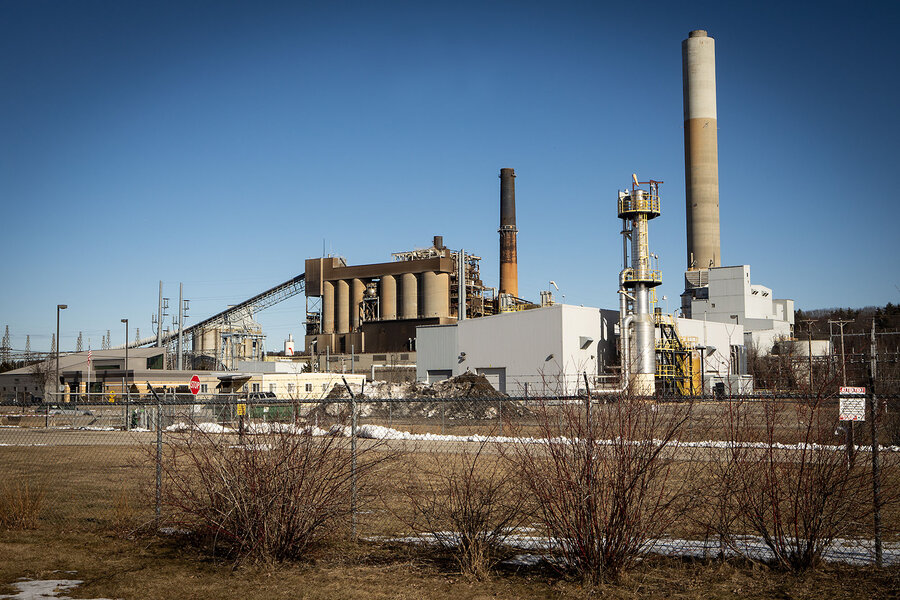The last coal plant in New England is sputtering. What happens next?
Loading...
| Bow, N.H.
On the banks of the Merrimack River, a coal-fired power plant sleeps for most of the year. Concrete smokestacks stand silent. The industrial sprawl is eerily quiet compared with the hum of producing electricity for decades.
One December morning, Nick Lydon spots a dark plume wafting through the air. On the coldest days of winter, the generators at Merrimack Station rumble into production, burning coal to generate electricity when demand peaks. But this day was different.
“That’s the first time that I ever looked at the smokestack and saw something other than just water vapor coming out of it,” says Mr. Lydon, who’s lived and worked here in Bow, New Hampshire, for two decades. “You could actually see, like, a clear trail of ash that was leaving the smokestack.”
Why We Wrote This
A story focused onNew England is on the verge of becoming the first region in the United States to go coal-free. What lessons does the last coal-fired plant in New Hampshire hold for the rest of the country?
The electrician already knew that the power plant had thrice failed to complete its sulfur emissions tests in 2023, and its electric output had been waning. Like so many across the United States living in coal towns, Mr. Lydon is focused on what comes next. And the state has set a deadline: Merrimack Station’s private owners must bring the plant into compliance with the New Hampshire Department of Environmental Services standards by March 23.
The last sputtering cough from Merrimack’s smokestacks will be the final breath of coal in New England. And residents say that it appears that economics has accomplished what more than a decade of protests alone did not. The region’s gradual transition away from coal has pushed New England’s last coal plant further out of competition.
When this power plant closes, it’ll mark the end of an energy era in New England. It will mark another milestone as well – the first region in the U.S. in over a century will be coal-free.
The shift is notable both for residents’ matter-of-fact acceptance of the coming closure and for a lack of consensus on what comes next.
“This is the final chapter of coal in the region” says Don Kreis, New Hampshire’s consumer advocate. “It’s pretty obvious [Merrimack Station’s] days are numbered. It is inevitably the case that we will completely stop using coal to produce electricity in New England.”
New England’s journey toward decarbonization is gaining momentum, with five out of six states firmly committed to slashing emissions by at least 80% by 2050. New Hampshire stands as the lone state without legally binding emission reduction targets. Neighboring Vermont has already been producing nearly 100% renewable energy since 2015.
The region’s power grid operator, ISO New England, says new resource proposals are dominated by wind power. Solar power is also growing rapidly. Renewable energies currently account for 40% of New England’s resource mix. Another 49% of the area’s power comes from natural gas.
The big question is whether the Bow plant will be added to the renewable or fossil fuel side of the ledger. Residents, state lawmakers, and clean-energy activists are all debating the plant’s future after summer 2025.
“The way you get a plant like Merrimack Station to close is by bringing online new clean resources that can compete in the market and push Merrimack out of the money. Now that’s happened,” says Sam Evans-Brown from Clean Energy New Hampshire.
A turning point
Just south of New Hampshire’s capital, Concord, the historic small town of Bow was founded in 1727. The town’s lifeline has always been its waterways, the town’s name originating from its establishment along a bend, or “bow,” in the Merrimack River.
Merrimack Station has been running fewer days every year. Last year, the two coal-fired generators ran for 500 hours, or about 21 days. The year before, it was 27 days.
Far past its glory days of serving roughly 450,000 homes, the fading fossil fuel factory produces less electricity each year. Other coal and oil plants in the region have switched energy sources or set a date for their eventual closure. Yet Merrimack Station has done neither.
It’s now been out of compliance for more than a year. Last February, Merrimack failed its emissions certification test. The New Hampshire Department of Environmental Services alleged the plant’s particulate matter emissions exceeded national standards by more than 70%.
Three more tests were scheduled. All three were uncompleted due to “mechanical failures,” which halted the tests before any final results could be verified.
“Last year the plant ran for like 500 hours total. And the question is, of those 500 hours, when was the public properly protected?” asks Catherine Corkery of the Sierra Club New Hampshire.
Longtime Granite State resident Mary Beth Raven spent the past five years advocating for the plant’s shuttering with the No Coal No Gas campaign. After raising her family in New Hampshire, Ms. Raven – who lives in Merrimack County – began letter-writing campaigns and demonstrations to boost awareness of climate change in her backyard.
“There’s still no official plan to shut it down. And tons of coal are still sitting there seeping into the groundwater and into the river. It’s still an issue that needs to be dealt with,” says Ms. Raven.
Granite Shore Power, a subsidiary of Atlas Holdings, confirmed in an interview with the Monitor that there were no official plans to shutter the power plant, but declined to be quoted.
What comes next?
There’s been no shortage of ideas for converting the plant. At the Statehouse, the plant’s owners and others have touted wind, solar, geothermal, nuclear, and even green hydrogen as possible replacements down the line. Which are practical, and which are even possible, remains to be seen.
While some focus on a fading fossil fuel factory, Mr. Lydon – who sits on Bow’s local energy committee – still sees an opportunity for clean energy in his town. “We don’t want coal in our town, but we already have a working power plant. So let’s use” that tie to the electrical power grid for clean energy, says Mr. Lydon.
“We don’t seem to have an answer for what comes next. But now, any plan that you have is going to take years,” he says. “It’s something that really should have been thought about, like, a long time ago, before we got to this point.”
The plant doesn’t generate as many jobs as it used to – right now, there are a few dozen, mostly seasonal, jobs. However, the utility still counts for about 8% of the city’s tax base. And some Bow residents say other parts of the country should take heed of the need for planning for the future.
“The plant’s always been the biggest entity that exists in the town,” says Mr. Lydon.
“If you take a major tax revenue like that out of the town, that’s going to leave a big hole in the local community. I don’t think anyone wants to see the plant just disappear,” he adds. “I just don’t think anyone wants to see it run as a coal plant anymore.”







